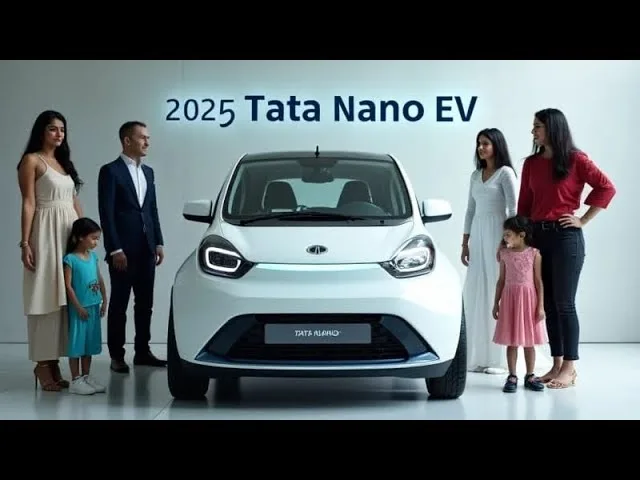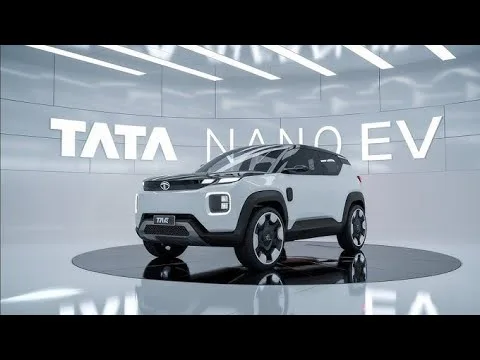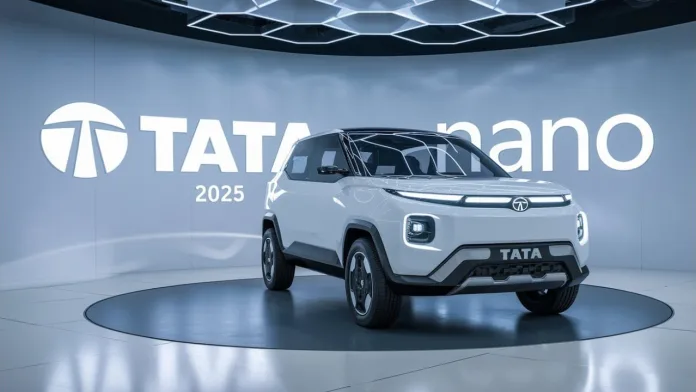Discover why the Nano EV in 2025 is set to revolutionize India’s electric vehicle market with its 400km range, affordable price, and smart features for urban mobility.
How the Tata Nano Evolved into an Electric Revolution
The story of the tata nano is one of vision and perseverance. What began as India’s most affordable car is now poised to make history again—this time in the electric vehicle space. The journey from the original tata nano to its electric avatar represents more than just technological advancement; it symbolizes India’s growing commitment to sustainable transportation.

When the original tata nano hit Indian roads in 2009, it made headlines as the world’s cheapest car. Fast forward to 2025, and Tata Motors, in collaboration with Jayem Automotive, is preparing to launch an electric version that maintains the original’s philosophy of accessibility while embracing the future of mobility.
“The legacy of the tata nano continues with this electric iteration, maintaining its philosophy of accessible transportation,” says automotive analyst Rahul Sharma. “But make no mistake—this isn’t just an electrified version of the old model. It’s a complete reimagining for the electric age.”
What Makes the Nano EV Special?
The Nano EV represents a significant step forward in affordable electric mobility for urban commuters. Unlike many electric vehicles that come with premium price tags, the Nano EV is designed to make electric mobility accessible to the average Indian family.
With its compact design and impressive range, the Nano EV is positioned to disrupt the entry-level electric vehicle market. It addresses the primary concerns that have historically held back EV adoption in India: cost, range anxiety, and charging infrastructure.
Technical Specifications of the nano electric car
The nano electric car features a high-tech lithium-ion superpolymer battery for optimal performance. Here’s a detailed look at what’s under the hood:
| Feature | Specification |
|---|---|
| Battery Capacity | 17.1 kWh |
| Range | 400 km per charge |
| Seating Capacity | 4 seater |
| Expected Price | Around Rs 4 lakh |
| Charging Time | 8 hours (full charge) |
| Acceleration | 0-60 mph in under 10 seconds |
Engineers have designed the nano electric car with urban mobility challenges in mind. The 400 km range on a single charge means most commuters would only need to charge their vehicle once or twice a week, depending on usage patterns.
The standard ev charging time of 8 hours for a full charge suits overnight home charging scenarios, making it practical for households without access to fast-charging stations.
Where the Nano EV Fits in Tata’s Lineup of tata ev cars
The growing lineup of tata ev cars demonstrates the company’s commitment to electric mobility. From the Nexon EV to the Tigor EV, Tata Motors has been steadily expanding its electric offerings.
Among the various tata ev cars, the Nano EV stands out for its affordability and urban-friendly design. It fills a crucial gap in the market—an entry-level electric vehicle that doesn’t compromise on range or features.
“Tata Motors continues to expand its portfolio of tata ev cars to cater to different market segments,” explains Vikram Gulati, an EV market specialist. “The Nano EV is strategically positioned to capture the mass market that’s currently underserved by existing electric options.”
Features and Innovations in the tata nano new model for 2025
The tata nano new model for 2025 features significant upgrades from its predecessors. Gone are the days of bare-bones transportation—the new Nano EV embraces modern technology and comfort features that today’s consumers expect.
Interior and Comfort Features
- 9-inch touchscreen display with smartphone connectivity
- Power windows and automatic climate control
- Modern and luxurious interior design compared to the original Nano
- Enhanced safety features including multiple airbags
- Regenerative braking system
Consumers can expect the tata nano new model to include advanced safety features and technology that were absent in the original Nano. The interior has been completely redesigned to offer a more premium feel while maintaining the vehicle’s compact footprint.
Timeline for the tata nano ev 2025 Release
The tata nano ev 2025 is currently in the prototype stage, with production models expected to hit showrooms in the latter half of 2025. Tata Motors has been conducting extensive testing to ensure the vehicle meets both performance expectations and safety standards.
Recent promotional activities featuring Bollywood actor Vicky Kaushal suggest that Tata is gearing up for a major marketing push as the launch date approaches.
What to Expect: tata nano ev price and Value Proposition

The expected tata nano ev price of around Rs 4 lakh makes it one of the most affordable electric vehicles in India. This pricing strategy is deliberate—Tata Motors aims to make electric mobility accessible to a broader demographic.
Consumers are eagerly awaiting the official announcement of the tata nano ev price. If Tata can deliver on the promised specifications at this price point, it could trigger widespread adoption of electric vehicles in India’s price-sensitive market.
Understanding the nano ev on road price Across Different States
The nano ev on road price will vary depending on state taxes and incentives for electric vehicles. States like Delhi, Maharashtra, and Gujarat offer significant subsidies for EV purchases, which could bring down the effective cost for buyers.
Government subsidies could significantly reduce the nano ev on road price for early adopters. Under the FAME II scheme, buyers could receive incentives based on the battery capacity, potentially saving lakhs of rupees.
Factors Affecting the nano ev price in India
Several factors will influence the final nano ev price in india:
- Battery costs: The lithium-ion battery pack represents a significant portion of the vehicle’s cost
- Import duties: Depending on the sourcing of components
- Government incentives: Both at the central and state levels
- Manufacturing scale: As production volumes increase, per-unit costs may decrease
- Competition: Pricing strategies of other manufacturers entering the affordable EV space
The Environmental Impact of the Nano EV
Beyond personal savings, the Nano EV represents a significant step toward reducing India’s carbon footprint. The transportation sector accounts for approximately 10% of India’s carbon emissions, and the shift to electric vehicles could help mitigate this environmental impact.
With an electric vehicle range of 400 km per charge, the Nano EV addresses one of the main concerns of potential EV buyers. This impressive range makes it practical for daily use without constant recharging.
The environmental benefits extend beyond just zero tailpipe emissions:
- Reduction in operational costs by up to 36.41% compared to conventional vehicles
- Minimum electricity cost of 3.11 INR/kWh for charging
- Potential integration with renewable energy sources for charging
- Contribution to improved air quality in urban areas
Market Outlook and Future Prospects
The EV battery market is projected to reach USD 251.33 billion by 2035, growing at a CAGR of 9.6% between 2024 and 2035. This growth reflects the increasing global shift toward electric mobility.
In this expanding market, the Nano EV is well-positioned to capture a significant share, particularly in emerging economies where affordability is a key consideration.
Competitive Landscape
| Competitor | Market Share | YoY Growth |
|---|---|---|
| BYD Co Ltd | 29.2% | 73.2% |
| Geely Automobile | 13.2% | 197.5% |
| Tesla | 3.8% | -11.2% |
| Xiaomi | 3.4% | New Entry |
While global players dominate the overall EV market, Tata’s understanding of local conditions and price points gives the Nano EV a competitive edge in the Indian market.
Why the Nano EV Makes Perfect Sense in 2025
As we look toward 2025, several factors converge to make the Nano EV not just viable but potentially transformative for India’s transportation landscape:
- Affordability: At around Rs 4 lakh, it brings electric mobility within reach of middle-class Indian families
- Practical Range: The 400 km range eliminates range anxiety for daily commuters
- Reduced Operating Costs: Lower maintenance and charging costs compared to conventional vehicles
- Environmental Benefits: Zero tailpipe emissions contribute to cleaner urban air
- Government Support: Increasing incentives for EV adoption at both central and state levels
“The Nano EV could do for electric vehicles what the original Nano did for car ownership in India—make it accessible to millions who previously couldn’t afford it,” notes environmental policy expert Anjali Prakash.

Maximizing the electric vehicle range of Your Nano EV
The impressive electric vehicle range makes the Nano EV suitable for both city commuting and occasional longer trips. To get the most out of your Nano EV’s battery, consider these tips:
- Maintain steady speeds: Constant acceleration and deceleration reduce efficiency
- Use regenerative braking: Let the car recover energy when slowing down
- Plan your routes: Avoid steep inclines where possible
- Optimize climate control: Pre-condition the car while it’s still plugged in
- Regular maintenance: Keep tires properly inflated and components in good working order
Tata has focused on maximizing the electric vehicle range without compromising on affordability. The 400 km range puts it ahead of many competitors in its price segment.
The Road Ahead for Affordable Electric Mobility
As we approach 2025, the Nano EV stands as a symbol of India’s evolving automotive landscape—one that embraces sustainability without sacrificing accessibility. For millions of Indians, it represents not just a new car but a gateway to participating in the global shift toward cleaner transportation.
The nano electric car combines affordability with modern features that today’s consumers expect. It’s not merely an economical choice but a forward-thinking one that aligns with both personal financial goals and broader environmental concerns.
With the tata nano new model representing Tata’s vision for the future of affordable transportation, the stage is set for a potential revolution in how India moves. The question is no longer if electric vehicles will become mainstream in India, but how quickly—and the Nano EV might just be the catalyst that accelerates this transition.


